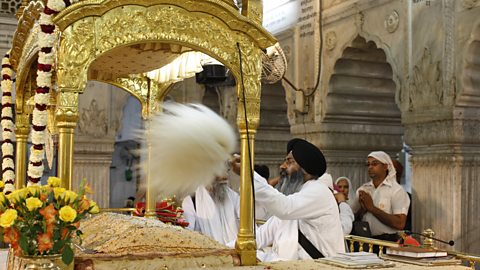Role of Guru Granth Sahib in worship
The Mool Mantra(Mool Mantar or Mul Mantra) The basic statement of belief that appears at the beginning and throughout the Guru Granth Sahib. , the opening sentence of the Guru Granth SahibThe Guru Granth Sahib is the most important Sikh holy book. It is a collection of songs, prayers and hymns from the Sikh Gurus and other holy men, as well as teachings from other faiths. It is treated as a living Guru., contains Guru NanakGuru Nanak was the founder of Sikhism and the first of the ten Gurus, who lived from 1469 to 1539. teaching about God and is recited daily in morning prayerCommunication with God. A means of developing a personal relationship with God..
The Guru Granth Sahib is treated as a living person and has its own room in the gurdwaraSikh place of worship. Literally, the 'doorway to the Guru'.. The person who looks after the Guru Granth Sahib is the granthiReader of the Guru Granth Sahib, who officiates at ceremonies. This can be a man or a woman. and he may lead the morning and evening services. However, any Sikh, male or female, who is able to do so, can lead public worship.

Sikh public worship has many symbolic elements.
- Treating the Guru Granth Sahib as a living Guru, eg by waking it in the morning and putting it to rest at night shows the belief that it has the same authority as other Gurus.
- Placing the Guru Granth Sahib on a throne under a canopy, covering it with rumallaBeautiful cloths or coverings which cover the Guru Granth Sahib when it is not being read. and waving the chauriFan waved over scriptures, made of yak hairs or nylon; symbol of the authority of the Guru Granth Sahib. over it shows the great respect with which it is held.
- Humility is shown by people taking off their shoes, covering their hair, bowing and sitting on a lower level to the Guru Granth Sahib.
- The Ik OnkarThere is only One God or 'God is One'. The first phrase of the Mool Mantar. It is also used as a symbol to decorate Sikh objects. symbol is found in the gurdwara to remind Sikhs of the Mool Mantar, that there is only one God.
- Eating Karah PrashadSanctified food ( a sweet pudding made from wheat flour, sugar, clarified butter and water) distributed at Sikh ceremonies. represents the equality of all.
Art and music within worship
Sikhs use art and music to express beliefs about God. The Ik onkar symbol focuses worship on the Oneness of God.
Most of Sikh scriptureA piece of writing that has religious significance. is in the form of hymnA religious song giving praise and worship to God. with directions about how they should be played and sung. The Guru Granth Sahib is arranged into 31 major ragas, which are sequences of notes intended to bring about a particular mood in the listener.
Singing kirtanDevotional singing of the compositions found in the Guru Granth Sahib. expresses devotion to WaheguruSikhs believe in one God called Waheguru which means тWonderful Lordт or тWonderful Teacherт. or Akal Purakh, meaning 'the Eternal One', a description of God used by Guru Nanak. It also creates a shared community experience.